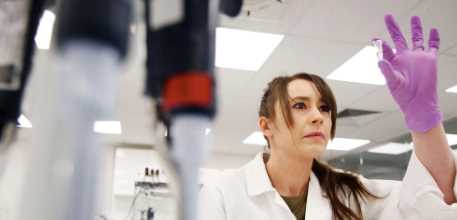Researchers from the University of Utah are stepping up to tackle the many concerns that are arising as COVID-19, the illness brought on by the novel coronavirus, spreads around the globe. For the purpose of creating and putting into practise countermeasures, solid research that explains how the unique virus originated, behaves, and spreads will be of immeasurable value.
In just a few short weeks, more than a dozen brand-new research studies in physics, biochemistry, and bioengineering have appeared around the U, and many more are in the works. With the help of financing for COVID-19 research and a virtual gathering that drew 207 people, the U's Immunology, Inflammation, and Infectious Disease Initiative quickly gathered support for these new initiatives.
Does the novel coronavirus react differently to changes in temperature and humidity?
How the coronavirus will be affected by the passing of the seasons is one of the main questions. Grant money was provided to Department of Physics & Astronomy researchers to address this query. Individual synthetic coronavirus particles without a genome will be made by the physicists, rendering the virus unable to replicate or cause infection. The coronavirus's resistance to variations in humidity and temperature will be tested, as well as the circumstances at which the virus disintegrates.
a medication to stop infection
A medication that either prevents or treats COVID-19 is something we absolutely need. By adapting a method they created against HIV, another viral disease, biochemists at U of U Health are moving toward that objective. They use the protein building block known as D-peptides to create mirror images of each other.
D-peptides are tiny compounds that block the spread of illness; they aren't broken down by the body because they aren't found in nature. The treatment may be made simpler and less expensive if one dose were to last a long time. This strategy might not assist with the present outbreak because it can take a while for new medications to be authorised.
the new coronavirus's antecedents
Most coronaviruses found in bats are probably harmless to humans. The ability of these viruses to exchange genetic material with one another, leading to the emergence of viruses that spread to people, has been discovered by scientists.
In order to determine the impact these exchanges may have played in the development of SARS-CoV-2, researchers in the Department of Human Genetics are searching the virus' genome for recent alterations and figuring out whether genetic exchange could have given the virus the ability to infect us and get past our immune systems. One day, new approaches to preventing viruses could be generated by understanding how harmless viruses become lethal.
Who ought to undergo COVID-19 testing?
Due to a global shortage of materials needed to produce them, we are currently living in a world where there are only a certain amount of COVID-19 tests available. In this case, it is better to save testing for those who are most at risk of contracting the illness and showing severe symptoms.
What about them? Doctors who specialise in infectious diseases are creating an online calculator using mathematical models of disease transmission and clinical data from patients who have already undergone testing.
When medical information is entered, a score that predicts the possibility that the patient will test positive is generated. The patient needs to undergo testing if the score is high. If the result is poor, the patient can keep track of their symptoms at home, possibly sparing a valuable test.
preparing for an improved future
We might be able to come up with solutions if we perceive that the future is bleak. Based on what is known about the novel, coronavirus's ability to spread from person to person and when combined with census data, epidemiologists are developing models. a forecast of the disease's potential spread and the anticipated number of cases in various regions of the nation.
When people take safeguards like social distance, scientists can use this virtual world to see how things can alter. In order to prepare for possible demands for beds, masks, ventilators, and other valuable but scarce supplies, the scientists are also creating scenarios particular to hospitals. With the use of these statistics, it is hoped that the grim future can be transformed into a bright one.




Leave Comment
1 Comments